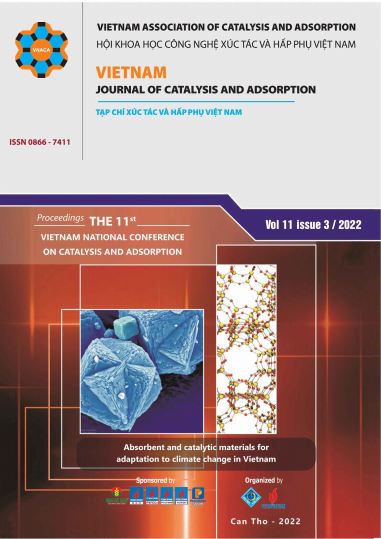Photocatalysis degradation of 2,4-dichlorophenoxyacetic acid in water environment using synthesized TiO2 nanoparticles
DOI:
https://doi.org/10.51316/jca.2022.048Keywords:
2,4-D, TiO2, nanomaterial, photocatalysisAbstract
The present study investigated the photodegradation of 2,4-Dichlorophenoxyacetic acid (2,4-D) in a water environment using synthesized titania nanoparticles (TiO2-NPs). The TiO2-NPs fabricated by sol-gel method were distinguished by X-ray diffraction (XRD) and Transmission electron microscopy (TEM), Infrared spectroscopy (IR), and zeta potential measurements. The results indicated that TiO2 - NPs were nanospheres of appropriately 30nm with a major anatase phase. Synthesized TiO2-NPs have the point of zero charge (PZC) of around 6.0. The efficient conditions for photocatalysis degradation of 2,4-D under sunlight were considered and found to be 120 min, pH 11, and 1 mM KCl. Under ideal conditions, the photodegradation efficiency of 2,4-D reached greater than 72 %. Our results suggest that TiO2-NPs would be promisingly applied for eliminating 2,4-D from an aqueous solution.
Downloads
References
De Castro Marcato, A.C., C.P. de Souza, and C.S. Fontanetti, Water, Air, & Soil Pollution 228-3 (2017) 120. http://doi.org/10.1007/s11270-017-3301-0.
Islam, F., et al., Environment international 111 (2017) 332-351. http://doi.org/10.1016/j.envint.2017.10.020
Ebrahimi, R., et al., Journal of Inorganic and Organometallic Polymers and Materials 30-3 (2020) 923-934. http://doi.org/10.1007/s10904-019-01280-3
Germaine, K., et al., FEMS microbiology ecology 57 (2006) 302-310. https://doi.org/ 10.1111/j.1574-6941.2006.00121.
Abdennouri, M., et al., Journal of Saudi Chemical Society, 19-5 (2015) 485-493. https://doi.org/10.1016/j.jscs.2015.06.007
Liu, L., et al., Chemical Engineering Journal,. 181-182 (2011) 189-195. https://doi.org/10.1016/j.cej.2011.11.060
Tsydenova, O., V. Batoev, and A. Batoeva, International journal of environmental research and public health 12 (2015) 9542-9561. https://doi.org/10.3390/ijerph120809542
Wang, J. and R. Zhuan, Science of The Total Environment, 701 (2020) 135023. https://doi.org/10.1016/j.scitotenv.2019.135023
Nguyen, V.-H., et al., Arabian Journal of Chemistry, 13 (2020) 8309-8667. https://doi.org/10.1016/j.arabjc.2020.04.028
Wen, J., et al., Chinese Journal of Catalysis,. 36 (12) (2015) 2049-2070. https://doi.org/10.1016/S1872-2067(15)60999-8
Dao, H., et al., Environmental Earth Sciences, 77 (2018) 359. https://doi.org/10.1007/s12665-018-7550-z
Nakata, K. and A. Fujishima, Journal of Photochemistry and Photobiology C: Photochemistry Reviews, 13(3) (2012) 169-189. https://doi.org/10.1016/j.jphotochemrev.2012.06.001
Paz, Y., Applied Catalysis B: Environmental, 99 (2010) 448-460. https://doi.org/10.1016/j.apcatb.2010.05.011
Crisan, M., et al., Journal of Dispersion Science and Technology 24 (2003) 129–144. https://doi.org/10.1081/DIS-120017952
Kosmulski, M., Journal of colloid and interface science,. 353 (2011) 1-15. https://doi.org/10.1016/j.jcis.2010.08.023
Bian, X., J. Chen, and R. Ji, Materials,. 6 - 4 (2013) 1530-1542. https://doi.org/ 10.3390/ma6041530
Downloads
Published
Issue
Section
How to Cite
Share
Funding data
-
Ministry of Science and Technology
Grant numbers ĐTĐL.CN-62.19










